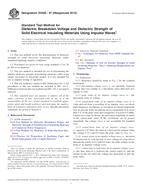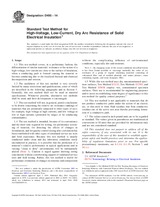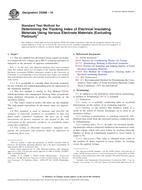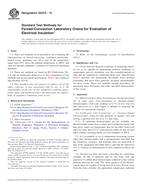Potrebujeme váš súhlas na využitie jednotlivých dát, aby sa vám okrem iného mohli ukazovať informácie týkajúce sa vašich záujmov. Súhlas udelíte kliknutím na tlačidlo „OK“.
ASTM D3426-97(2012)
Standard Test Method for Dielectric Breakdown Voltage and Dielectric Strength of Solid Electrical Insulating Materials Using Impulse Waves
Automaticky preložený názov:
Štandardná skúšobná metóda pre Dielektrická napätia a elektrickej pevnosti Solid Elektroizolačné materiály Použitie nárazy
NORMA vydaná dňa 1.11.2012
Informácie o norme:
Označenie normy: ASTM D3426-97(2012)
Poznámka: NEPLATNÁ
Dátum vydania normy: 1.11.2012
Kód tovaru: NS-23606
Počet strán: 4
Približná hmotnosť: 12 g (0.03 libier)
Krajina: Americká technická norma
Kategória: Technické normy ASTM
Kategórie - podobné normy:
Anotácia textu normy ASTM D3426-97(2012) :
Keywords:
dielectric breakdown, dielectric breakdown criteria, dielectric breakdown voltage, dielectric strength, full-impulse-voltage wave, impulse dielectric strength, impulse generator, impulse waves, lightning strokes, peak value, simulated-lightning impulse, solid insulating material, virtual front time, virtual origin, virtual peak value, virtual time to half-value, ICS Number Code 29.035.01 (Insulating materials in general)
Doplňujúce informácie
| Significance and Use | ||||||||||
|
5.1 Insulating materials used in high-voltage equipment may be subjected to transient voltage stresses, resulting from such causes as nearby lightning strokes. This is particularly true of apparatus such as transformers and switchgear used in electrical-power transmission and distribution systems. The ability of insulating materials to withstand these transient voltages is important in establishing the reliability of apparatus insulated with these materials. 5.2 Transient voltages caused by lightning may be of either positive or negative polarity. In a symmetrical field between identical electrodes, the polarity has no effect on the breakdown strength. However, with dissimilar electrodes there may be a pronounced polarity effect. It is common practice when using dissimilar electrodes, to make negative that electrode at which the higher gradient will appear. When asymmetrical electrodes are used for testing materials with which the tester has no previous experience or knowledge, it is recommended that he make comparative tests with positive polarity and negative polarity applied to the higher gradient, or smaller electrode, to determine which polarity produces the lower breakdown voltage. 5.3 The standard wave shape is a 1.2 by 50-μs wave, reaching peak voltage in approximately 1.2 μs and decaying to 50 % of peak voltage in approximately 50 μs after the beginning of the wave. This wave is intended to simulate a lightning stroke that may strike a system without causing failure on the system. 5.4 For most materials, the impulse dielectric strength will be higher than either its power frequency alternating voltage or its direct voltage dielectric strengths. Because of the short time involved, dielectric heating and other thermal effects are largely eliminated during impulse testing. Thus, the impulse test gives values closer to the intrinsic breakdown strength than do longer time tests. From comparisons of the impulse dielectric strength with the values obtained from longer time tests, inferences may be drawn as to the modes of failures under the various tests for a given material. Appendix X1 of Test Method D149 should be referred to for further information on this subject. |
||||||||||
| 1. Scope | ||||||||||
|
1.1 This test method covers the determination of dielectric strength of solid electrical insulating materials under simulated-lightning impulse conditions. 1.2 Procedures are given for tests using standard 1.2 by 50 μs full-wave impulses. 1.3 This test method is intended for use in determining the impulse dielectric strength of insulating materials, either using simple electrodes or functional models. It is not intended for use in impulse testing of apparatus. 1.4 This test method is similar to IEC Publication 243-3. All procedures in this test method are included in IEC 243-3. Differences between this test method and IEC 243-3 are largely editorial. 1.5 This standard does not
purport to address all of the safety concerns, if any, associated
with its use. It is the responsibility of the user of this standard
to establish appropriate safety and health practices and determine
the applicability of regulatory limitations prior to use.
C 68.1 Techniques for Dielectric Tests (IEEE
Standard No. 4) Available from American National Standards
Institute (ANSI), 25 W. 43rd St., 4th Floor, New York, NY
10036. Pub 243-3 Methods of Test for Electric Strength of
Solid Insulating Materials--Part 3: Additional Requirements for
Impulse Tests Standard Practice for Preparation of
Insulating Paper and Board Impregnated with a Liquid Dielectric Standard Test Methods for Thickness of
Solid Electrical Insulation Standard Test Method for Dielectric
Breakdown Voltage and Dielectric Strength of Solid Electrical
Insulating Materials at Commercial Power Frequencies |
Podobné normy:
Historická
1.4.2014
Historická
15.1.2010
Historická
1.9.2013
Historická
1.3.2010
Historická
1.1.2012
Historická
1.4.2011
Odporúčame:
Aktualizácia technických noriem
Chcete mať istotu, že používate len platné technické normy?
Ponúkame Vám riešenie, ktoré Vám zaistí mesačný prehľad o aktuálnosti noriem, ktoré používate.
Chcete vedieť viac informácií ? Pozrite sa na túto stránku.



 ASTM D495-14
ASTM D495-14 ASTM D5288-10
ASTM D5288-10 ASTM D5374-13
ASTM D5374-13 ASTM D5424-10
ASTM D5424-10 ASTM D5470-12
ASTM D5470-12 ASTM D6113-11
ASTM D6113-11
 Cookies
Cookies
